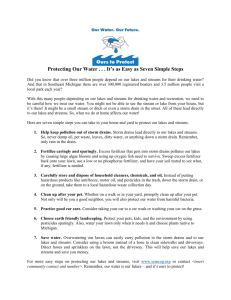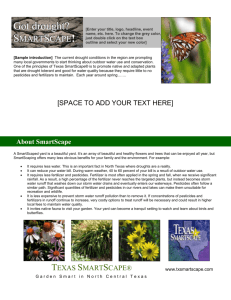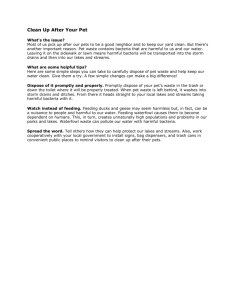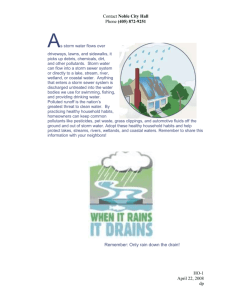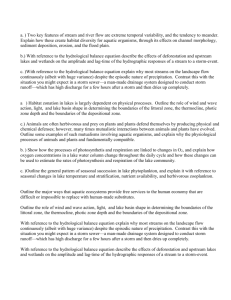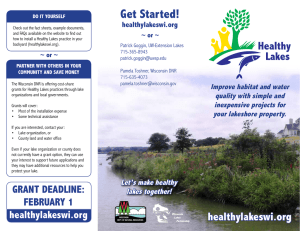Lake-friendly Yard Maintenance Managing waste on lakefront property BMP
advertisement
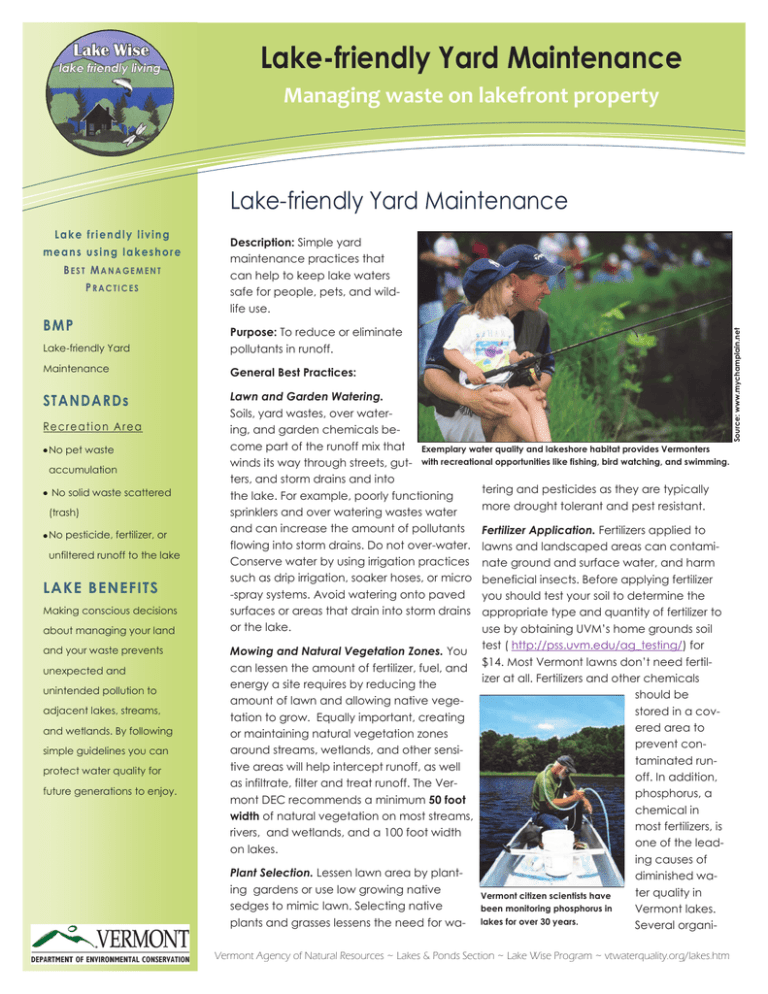
Lake-friendly Yard Maintenance Managing waste on lakefront property Lake-friendly Yard Maintenance means using lakeshore BEST MANAGEMENT PRACTICES BMP Description: Simple yard maintenance practices that can help to keep lake waters safe for people, pets, and wildlife use. Lake-friendly Yard Purpose: To reduce or eliminate pollutants in runoff. Maintenance General Best Practices: STANDARDs Lawn and Garden Watering. Soils, yard wastes, over watering, and garden chemicals become part of the runoff mix that Exemplary water quality and lakeshore habitat provides Vermonters winds its way through streets, gut- with recreational opportunities like fishing, bird watching, and swimming. ters, and storm drains and into tering and pesticides as they are typically the lake. For example, poorly functioning more drought tolerant and pest resistant. sprinklers and over watering wastes water and can increase the amount of pollutants Fertilizer Application. Fertilizers applied to flowing into storm drains. Do not over-water. lawns and landscaped areas can contamiConserve water by using irrigation practices nate ground and surface water, and harm such as drip irrigation, soaker hoses, or micro beneficial insects. Before applying fertilizer -spray systems. Avoid watering onto paved you should test your soil to determine the surfaces or areas that drain into storm drains appropriate type and quantity of fertilizer to or the lake. use by obtaining UVM’s home grounds soil Recreation Area No pet waste accumulation No solid waste scattered (trash) No pesticide, fertilizer, or unfiltered runoff to the lake LAKE BENEFITS Making conscious decisions about managing your land and your waste prevents unexpected and unintended pollution to adjacent lakes, streams, and wetlands. By following simple guidelines you can protect water quality for future generations to enjoy. test ( http://pss.uvm.edu/ag_testing/) for Mowing and Natural Vegetation Zones. You $14. Most Vermont lawns don’t need fertilcan lessen the amount of fertilizer, fuel, and izer at all. Fertilizers and other chemicals energy a site requires by reducing the should be amount of lawn and allowing native vegestored in a covtation to grow. Equally important, creating ered area to or maintaining natural vegetation zones prevent conaround streams, wetlands, and other sensitaminated runtive areas will help intercept runoff, as well off. In addition, as infiltrate, filter and treat runoff. The Verphosphorus, a mont DEC recommends a minimum 50 foot chemical in width of natural vegetation on most streams, most fertilizers, is rivers, and wetlands, and a 100 foot width one of the leadon lakes. ing causes of Plant Selection. Lessen lawn area by plantdiminished waing gardens or use low growing native ter quality in Vermont citizen scientists have sedges to mimic lawn. Selecting native been monitoring phosphorus in Vermont lakes. plants and grasses lessens the need for wa- lakes for over 30 years. Several organiVermont Agency of Natural Resources ~ Lakes & Ponds Section ~ Lake Wise Program ~ vtwaterquality.org/lakes.htm Source: www.mychamplain.net Lake friendly living Lake-friendly Yard Maintenance Managing waste on lakefront property Pesticides. Instead of pesticides, use pest management involving physical controls such as barriers or traps, biological controls (e.g. green lacewings that eat aphids), and bacterial insecticides (e.g. Bacillus thuringiensis that kill caterpillars). Chemical control should be considered a last resort. The following are the least harmful: dehydrating dusts (e.g. silica gel or diatomaceous earth), insecticidal soaps, boric acid powder, horticultural oils, and pyrethrinbased insecticides. possible. Clean up spilled fluids with an absorbent material like kitty litter or sand and dispose of the absorbent material properly. Never dispose of oil or other engine fluids by dumping it down storm drains, on the ground, or into a ditch. Many auto supply stores and gas stations accept used oil. Pet Waste. Pet waste left on the ground can be carried away by runoff, contributing bacteria, parasites and viruses to downstream water bodies. Pet waste does not fertilize the ground and can be the cause of significant pollution that presents health risks to adults, children and other pets. Source: http://www.zerowasteusa.com zations have been promoting the “Don’t ‘P’ on your Lawn” campaign, which informs landowners of the harmful effects excessive phosphorus has on the environment. For more information visit this site: www.lawntolake.org. Source: www.lifestyle.ca.msn.com To properly dispose of animal waste, use newspaper, bags, If you must use a pesticide, use or pooper-scoopers to pick one that is specifically deup wastes. Place wrapped signed to control your pest and use only as directed. The pet waste in the trash or unwrapped in a toilet. Never disinsect should be listed on the label. Approximately 90% of card pet waste in a storm drain or in the lake. the insects on your lawn and garden are not harmful. Yard Scraps. Leaves, grass clippings, and tree trimmings can Dumping toxics into the street, gutter or storm drain is illegal. clog catch basins and storm drains, increasing the risk of Household toxics–such as pesticides, cleaners, paints and flooding. Yard scraps that motor oil–can pollute and poison lakes, streams and rivers if enter rivers absorb oxygen as disposed of in storm drains or gutters. Rinse empty pesticide they decompose, straining or containers and dispose of rinse water per the instructions on killing aquatic life. Do not the product container. Dispose of empty rinsed containers in blow or rake leaves into the the trash. gutter, storm drain, or street Automobiles. When washing automobiles use products that (unless there is an active deswill break down more easily and are less toxic to plants. ignated municipal leaf pickup Soap should be used sparingly. Wash your car on a grassy scheduled). Use approved area to infiltrate and treat soapy water. Commercial car containers for curb side pickwashes reuse wash waup of lawn scraps, do your ter several times before own composting, or take sending it to a wastescraps to a landfill that comwater treatment facility posts. for treatment. Household Cleaners and Other Chemicals. It is important to Check your car, boat, dispose of cleaners and chemicals in the proper manner. motorcycle, and other Read the instructions on the container or contact your local machinery and equiptransfer station or waste management district. For more ment for leaks and spills. information visit: www.anr.state.vt.us/dec/wastediv/solid/ Make repairs as soon as swmdlist.htm. Vermont Agency of Natural Resources ~ Lakes & Ponds Section ~ Lake Wise Program ~ vtwaterquality.org/lakes.htm
